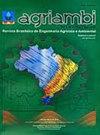Morphophysiology of mini watermelon in hydroponic cultivation using reject brine and substrates
IF 1.4
4区 农林科学
Q3 AGRICULTURAL ENGINEERING
Revista Brasileira de Engenharia Agricola e Ambiental
Pub Date : 2021-06-01
DOI:10.1590/1807-1929/AGRIAMBI.V25N6P402-408
引用次数: 11
Abstract
The objective of the study was to evaluate the growth and physiological aspects of the ‘Sugar Baby’ mini watermelon grown in a hydroponic system with different substrates and mixtures of reject brine in the preparation of the nutrient solution. For this purpose, the experiment was carried out in a plastic greenhouse, using a randomized block design, in a 5 x 4 factorial scheme, corresponding to the combination of five mixtures of reject brine (electrical conductivity EC = 9.50 dS m-1) and tap water (EC = 0.54 dS m-1) and four types of substrates (coconut fiber, sand, 70% sand + 30% rice husk and 40% sand + 60% rice husk), distributed in four replicates. Using the mixture of reject brine and tap water with EC above 4.00 dS m-1 to prepare the nutrient solution of mini watermelon plants markedly reduced their growth. Increments in carboxylation efficiency and activity in the electron transport chain act as tolerance mechanisms to compensate for the net photosynthesis of mini watermelon under salt stress. Coconut fiber promoted the best growth and photosynthetic activity for mini watermelon plants, while the substrate with 100% washed sand led to the lowest performance.弃置卤水和基质水培小型西瓜的形态生理特征
本研究的目的是评估“糖宝宝”迷你西瓜在不同基质和配制营养液的废盐水混合物的水培系统中生长和生理方面的影响。为此,在塑料大棚中采用随机区组设计,采用5 × 4因子方案,将5种废盐水(电导率EC = 9.50 dS - m-1)和自来水(EC = 0.54 dS - m-1)的混合物和4种基质(椰子纤维、沙子、70%沙子+ 30%稻壳和40%沙子+ 60%稻壳)的组合分布在4个重复中。用EC值在4.00 dS - m-1以上的弃置卤水与自来水混合配制的营养液对小型西瓜植株的生长有明显的抑制作用。盐胁迫下,小西瓜羧基化效率和电子传递链活性的增加是补偿净光合作用的耐受机制。椰子纤维对迷你西瓜植株生长和光合活性的促进作用最好,而100%水洗砂对迷你西瓜植株生长和光合活性的促进作用最低。
本文章由计算机程序翻译,如有差异,请以英文原文为准。
求助全文
约1分钟内获得全文
求助全文
来源期刊

Revista Brasileira de Engenharia Agricola e Ambiental
Agricultural and Biological Sciences-Agronomy and Crop Science
CiteScore
2.70
自引率
16.70%
发文量
114
审稿时长
3-8 weeks
期刊介绍:
A Revista Brasileira de Engenharia Agrícola e Ambiental (Agriambi), periódico oficial da Asociación Latinoamericana y del Caribe de Ingeniería Agrícola (ALIA), é editada mensalmente, no formato eletrônico, pela Unidade Acadêmica de Engenharia Agrícola (UAEA) do Centro de Tecnologia e Recursos Naturais (CTRN) da Universidade Federal de Campina Grande (UFCG), destinando-se à divulgação de artigos científicos originais e inéditos, elaborados em Português, Inglês ou Espanhol. Com o auxílio de pareceres de Consultores, os artigos são aceitos ou não pela Equipe Editorial para publicação na Revista. A Agriambi aceita, também, a submissão de contribuições na modalidade de revisão de literatura.
 求助内容:
求助内容: 应助结果提醒方式:
应助结果提醒方式:


